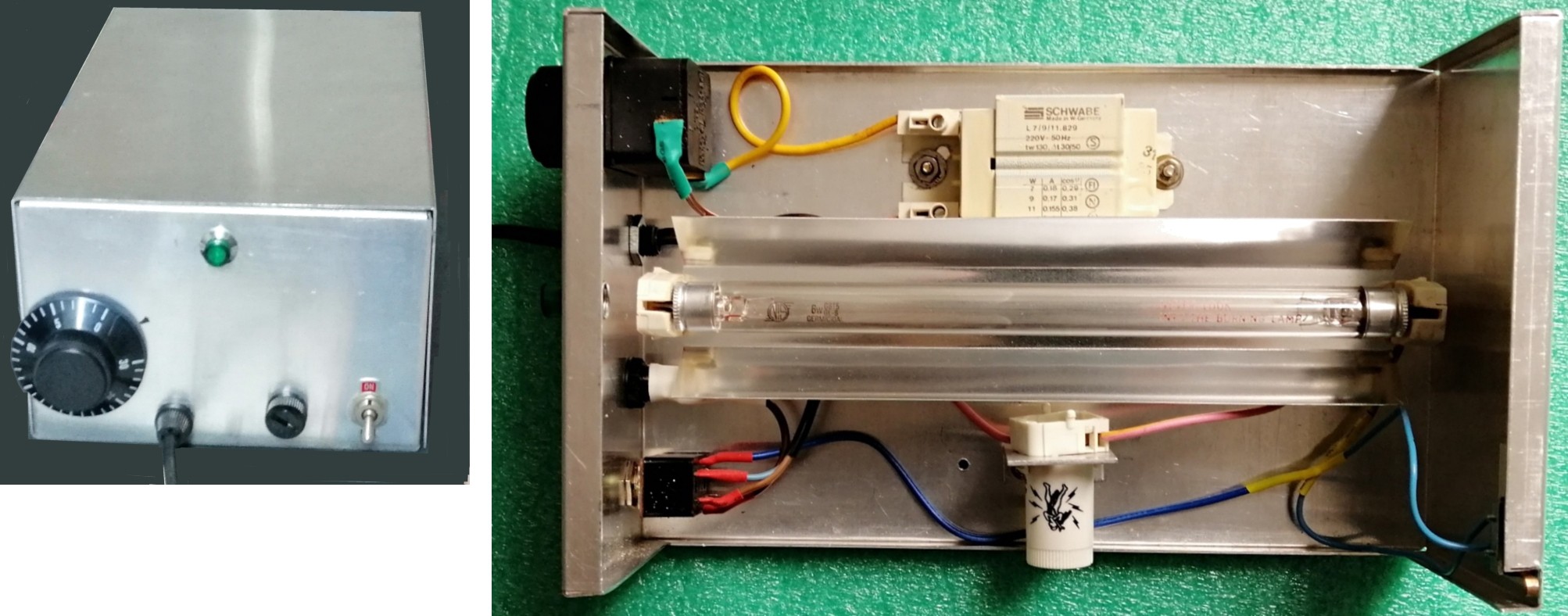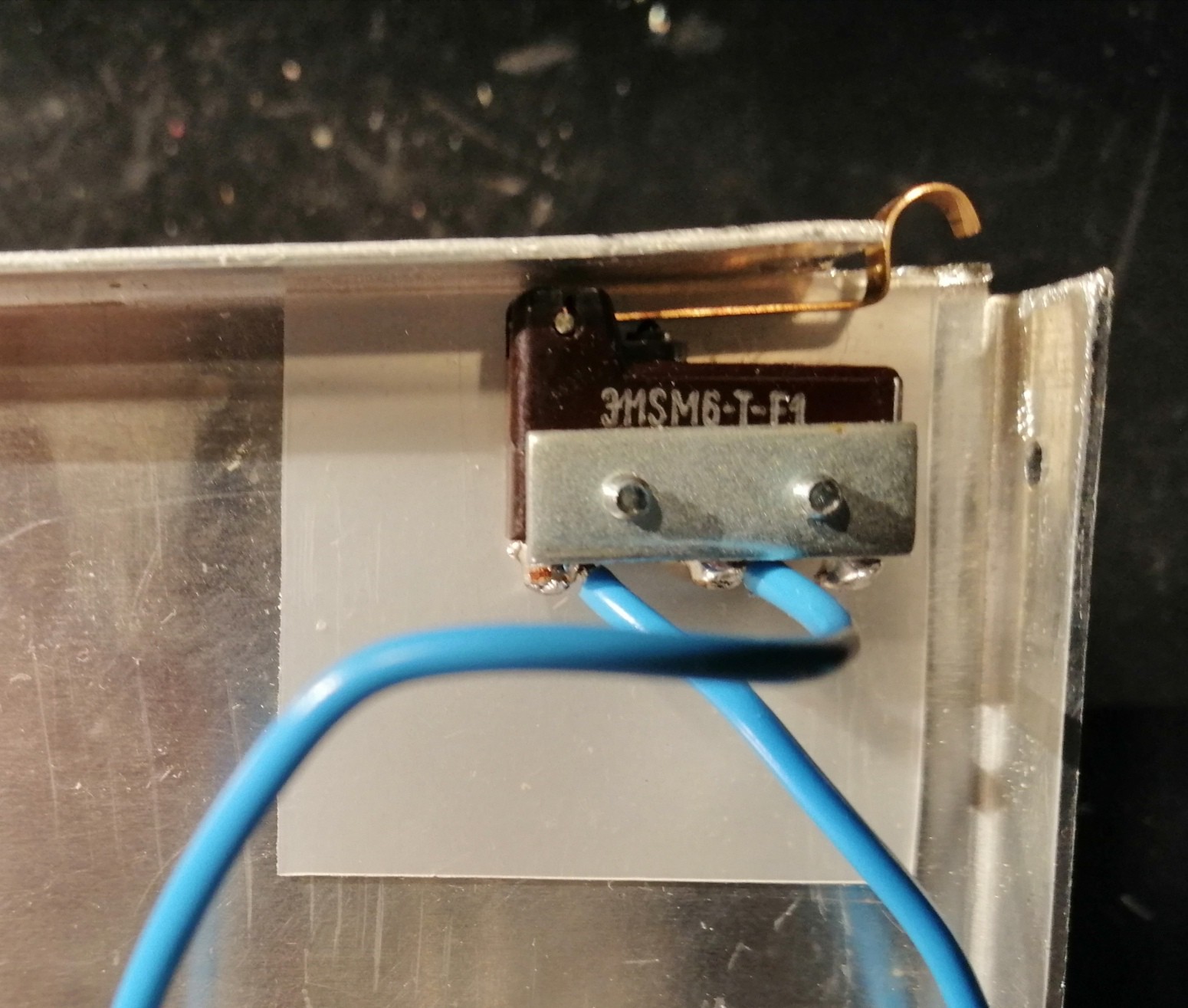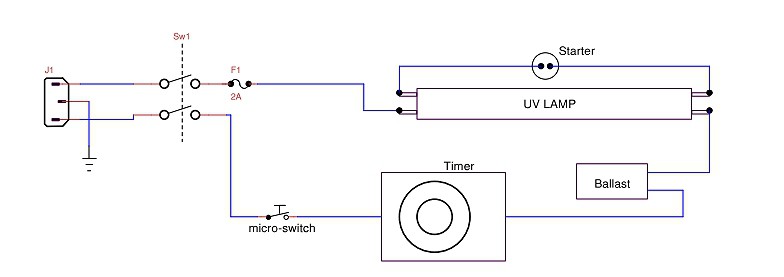The lamp
The lamp of my eraser, shown in figure 1, was quite suitable as a germicide.

Figure 1
It is a transparent fluorescent tube, having no internal phosphor coating, with an electric power of 6W. The lamp housing is made of molten quartz or Vycor as the common glass filters UVC rays. The efficiency is around 28-30%, which means that the typical effective radiated power is 1.7W so it is better to use an aluminum reflector to put under the lamp to make the most of it, as seen in the prototype photos. Even a thin sheet of aluminum, like the one used in the kitchen, acts very well as a reflector if glued on a rigid support.
As you can see from the photo, the lamp has the word "GERMICIDAL" G6T5 GL-6. It is not difficult to find them on the market (Amazon, eBay, etc) because they are widely used for the disinfection of air and water. Philips and Osram also produce several lamps with a wavelength of 253.7 nm (UVC). The cost is usually less than € 10.
Warning, UVC lamps are very harmful to the eyes and skin, therefore all precautions must be taken, as I did in my project.
The lamp, like all fluorescent tubes, requires a ballast suitable for its power and a starter.
A tanning lamp (UVA) is not good or, in any case, does not have the same effectiveness. Even the black fluorescent tubes, coated with special phosphors that filter the visible light (> 400 nm), emit UVA radiation.
Germicidal lamps made with UVC LED arrays are also on the market, but these are of higher wavelength (265-290 nm). From what I have seen in the datasheets, these LEDs have not high powers and low yields (maximum 10%), therefore different ones are needed and they are also quite expensive. They have the advantage that, like all LEDs, they concentrate radiation in a narrow beam, typically 100-120 °, so they do not require a reflector. They are also more compact and simpler as an electrical circuit.
Exposure time calculations
From various scientific publications it appears that, for a 99% sanitization, the energy density of UVC radiation must be:
e = 16.3 [mW×s/cm2]
Now we can theoretically calculate the power density at a certain distance d from the source, which we can consider cylindrical. A 6W TUV G5 lamp by Philips (wavelength = 253.7 nm) has a length of about 20 cm and a diameter of 1.6. The area at a distance of 10 cm is:
A= 2p * d*l = 2p*10.8*20=1357 [cm2]
Where d = 10 + 1.6/2 = 10.8, so the power density will be:
p = P/A = 1.5/1357 = 1105 [µW/cm2]
The exposure time is equal to the ratio e/p, so:
t = e/p = 16300/1105 = 14.75 [s]
This time is better to increase, for safety. In my case I used a one minute time.
By placing a reflector behind the lamp the beam concentrates and considerably increases the power density.
With more powerful lamps and with longer exposure times, rooms can also be sanitized without using chemicals. Obviously there must be no living beings during sterilization as these radiation are ionizing.
My realization
I made my system with what I had at home. I disassembled the lamp, ballast, starter and timer from the old eraser and mounted them in a suitably sized aluminum cabinet, as seen in the images in figure 2.

Figure 2
On the bottom right side I mounted a micro-switch to turn off the lamp when the cover is open, as seen in figure 3. The timer used is mechanical.

Figure 3
Of course you could make this system in better ways, perhaps by inserting a support for the mask, but I made it with what I had at home.
The green light that can be seen at the top acts as a simple slide, lights up with the light of the lamp and indicates that it is working.
The scheme is shown in figure 4.

Figure 4
Parts list
- 6W UVC lamp (254 nm) Philips TUV TL or Osram HNS 6 W G5 or compatible.
- 2 lamp holders with G5 socket.
- Starter complete with 6-9W ballast or electronic ballast.
- Micro-switch.
- 0.5 A fuse and fuse holder.
- Double switch, power cord with earth.
- 1-10 minute electronic or mechanical timer.
- 25x15x10 cm aluminum case.
- 21x12 cm aluminum reflector, 4 + 4 + 4 cm folded (trapezoidal section).
References
1. “Ultraviolet”, https://en.wikipedia.org/wiki/Ultraviolet
2. “Philips TUV TL Mini”,
3. “HNS 6 W G5, PURITEC HNS UV-C”, OSRAM GmbH, April 17, 2020.
4. “ULTRAVIOLET DISINFECTION GUIDANCE MANUAL FOR THE FINAL LONG TERM 2 ENHANCED SURFACE WATER TREATMENT RULE”, EPA 815-R-06-007, November 2006.
5. “How to Interpret UVC LED Data Sheet Values and Figures”, Kevin Kahn, https://www.klaran.com/klaran-university.
6. “GD Series UVC LEDs” Klaran ® .
7. “VLMU35CM..-280-120, UVC Emitting Diode in SMD Package”, Vishay Semiconductors, Rev. 1.0, 29-Nov-2018.
8. “Inactivation of Viruses on Surfaces by Ultraviolet Germicidal Irradiation”, Chun-Chieh Tseng and Chih-Shan Li, Journal of Occupational and Environmental Hygiene, 4: 400–405, 2007
 Giovanni Carrera
Giovanni Carrera